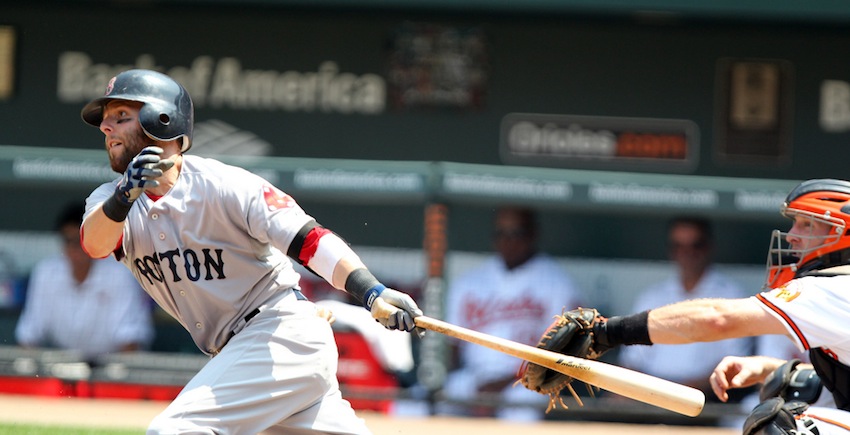What Would the Red Sox Look Like Without Free Agency?
Earlier this week, It’s About the Money, a Yankees blog and SNY affiliate, examined what the rosters of all 30 Major League Baseball teams would look like with only homegrown talent. In other words, they returned baseball to pre-1980 conditions, before the implementation of free agency as we know it today, when all players were subject to the reserve clause and rarely jumped from team to team … unless, of course, your owner sold you to your rival for $125,000.
Among other things, It’s About the Money concluded that the Red Sox would have an intriguing and familiar looking team, built around the heart of the 2013 squad. It’s About the Money’s Domenic Lanza looked at players’ offensive production and positional value to build a roster for each team using their homegrown players. Here’s how the Red Sox look, via IATM:
Boston Red Sox
Starting Pitchers
• Clay Buchholz
• Felix Doubront
• Jon Lester
• Justin Masterson
• Anibal Sanchez
Bullpen
• Daniel Bard
• Rafael Betancourt
• Michael Bowden
• Hideki Okajima
• Jonathan Papelbon
• Junichi Tazawa
• Brandon Workman
Catchers
• Ryan Lavarnway
• Kelly Shoppach
Infielders
• Jose Iglesias
• Jed Lowrie
• Dustin Pedroia
• Hanley Ramirez
• Anthony Rizzo
Outfielders
• Jacoby Ellsbury
• Ryan Kalish
• David Murphy
• Daniel Nava
• Josh Reddick
Designated Hitter
• Brandon Moss
In case you skimmed that list, Lanza summarizes it well, saying, “the core to [the team’s] successes in the last decade or so remains intact.” More than just a creative—not to mention time intensive—exercise, this approach to roster evaluation gives insight into why the non-fictional Red Sox have enjoyed long-term success over the past decade-plus, albeit with a hiccup or two.
Indeed, the organization has been better than most at identifying and developing talent; in the hypothetical world without free agency, Boston would be one of the more competitive teams in baseball and would be vying with the Tampa Bay Rays—a team renowned for its ability to scout talent—in the AL East. Secondly, and perhaps more importantly, the Red Sox have also largely invested long-term in the right players. Even with the theoretical return of Hanley Ramirez, Josh Reddick, and Justin Masterson, the foundation of the team would be made up of players currently on the roster: Dustin Pedroia, Jacoby Ellsbury, Clay Buchholz, and Jon Lester. As other organizations and their fans can attest, identifying and developing talent is only half of the equation. Teams like the Rays that can’t afford to keep homegrown talent when that talent hits free agency or teams that leverage their prospects for the wrong players, like the Mariners, either must continue to bolster their farm system, as the Rays have, or leave their fans wondering what might have been, as the Mariners have.
The Red Sox have avoided both of these issues by extending much of their homegrown talent—aided by the fourth largest payroll in baseball—and by making shrewd moves when swapping prospects for established players. While the Bailey-for-Reddick and Melancon-for-Lowrie trades will elicit groans, there haven’t been many other clear misses for the Red Sox during the Epstein and (in a smaller sample) Cherrington regimes. Other deals, like Victor Martinez for Justin Masterson et al, may tilt one way or the other, but it’s hard to declare a clear winner or loser. Martinez played just 183 games in Boston, over two shortened seasons, but he hit .313 with 28 home runs, with an on base percentage close to .900 over that time. Masterson, meanwhile, has oscillated between a front-end starter and a replacement-level pitcher.
The most interesting—and scrutinized—move, however, remains the 2005 megadeal with the Marlins that brought Josh Becket and Mike Lowell to Boston and netted the Marlins then-top-prospects Hanley Ramirez, Anibal Sanchez, and others. Given Beckett and Lowell’s prominent roles in the Red Sox ‘s 2007 World Series and Ramirez’s parabolic career, it’s hard to argue against Boston’s side of the deal. It should be noted, however, that despite the organization’s deep pockets, they have failed to find a true successor to Nomar Garciaparra—a span of nearly a decade without consistent shortstop play. Lowell and Beckett, meanwhile fell off—dramatically in Beckett’s case—after the 2007 season, and neither player ever recaptured their levels of production from that season. Sanchez, meanwhile, has quietly been the most consistent player involved in the deal, and is enjoying his most successful season in the majors this year, albeit in Detroit. All totaled, both teams would likely make the trade again, an impressive statement for such a monumental deal.
Ultimately, decisions like these are what make the Red Sox frequent World Series contenders. The ability to outspend the majority of the competition shouldn’t be discounted, either. But, as this fictional roster reminds us, nor should the organization’s development of talent and subsequent selectivity when determining how best to construct their roster.



